Common types of orchids
Orchids represent the family of orchids and are common on all continents. Many decades ago, they became popular indoor flowers. The types of room orchids are so numerous that it is impossible to describe everything in one article. Here are the most popular varieties and hybrids of different genera.
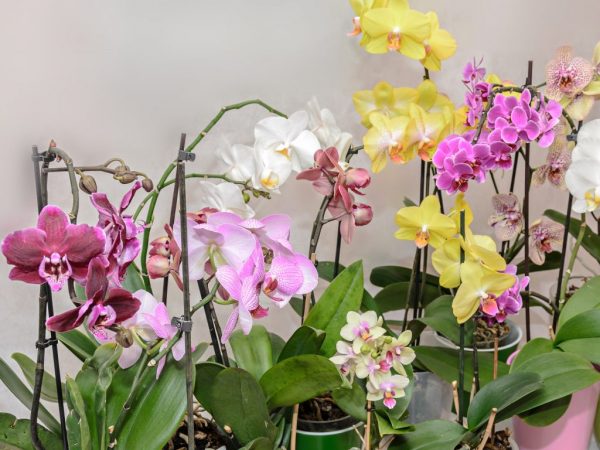
Common types of orchids
Description of orchids
Most indoor orchids are bred from species that grow in the tropics and equatorial forests. The very name of the flower comes from the Greek word "orchis", which means "egg". It is associated with the specific oval shape of the root. In oriental languages, the name of the flower sounds differently. For example, in Japanese it is "noun". About 10% of all plants in the world are orchids.
A characteristic feature of the flower is the accrete stamen and pistils, which are called the "column". Flowers are collected in racemose or spike-shaped inflorescences, rarely solitary. Their two petals are the same, the third is elongated, forming a lip. Sepals are composed of 3 petals. The fruit of an orchid is a capsule or a berry.
Orchids are herbaceous plants. They are divided into several groups according to the way of growth:
- Epiphytic. Mostly tropical species that grow on trees, making their way up the trunk towards the light that is lacking in the dense jungle.
- Lithophytic. They live on roots, in arid mountainous or lowland areas.
- Terrestrial. Such species are typical for the temperate zone, their roots are fixed in the soil.
- Underground. A rare Australian flower that is completely hidden underground and pollinated by ground insects.
According to the modern scientific classification, orchids are divided into subfamilies:
- apostasy;
- cypripedia;
- vanilla;
- epidendric;
- orchids, or orchids.
Indoor orchids can belong to any of these subfamilies. In addition, there are dozens of genera. Flowers have become a symbol of several countries. They are also described in the literature. For example, in the popular detective story "The Jade Empress Cixi".
Catacetum
The genus Catasetum is an epiphytic orchid that includes more than 150 species. Their homeland is South and Central America, most of all varieties grow in Brazil.
A peculiarity of the genus is the presence of flowers of different sexes in a plant. Male large, rich yellow-purple color, with a cupped lip hanging over the petals. Women's small ones, covered with a waxy coating. At home, it is rarely possible to achieve this type of flowering, either male or female buds bloom.
The stem height is 50-60 cm, at the same time the plant produces several peduncles. In November it goes to rest, wakes up in early March. Popular varieties of orchids of the genus Katasetum:
- Advanced;
- Spotted;
- Cap-shaped;
- All-edge;
- Drooping;
- Gloomy;
- Schmidt.
The variety is suitable for growing in an apartment, but in summer it is advisable to take the flower to the balcony or terrace.
Aganizia
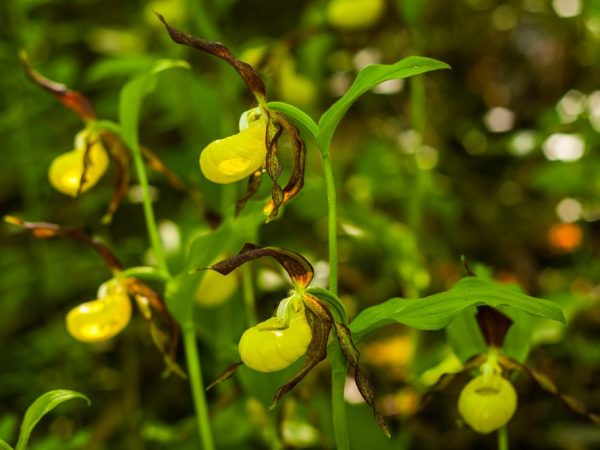
The variety of orchid varieties is great
The genus Aganizia, or Akakallis, from the orchid family, is one of the smallest in the world. It has only 4 species, of which 2 are grown at home. Epiphytic growth, shoots are arranged in a ladder at a distance of 3-6 cm from each other. Pseudobulbs are light green, narrowed and elongated. Leaves are lanceolate or elliptical, with a pointed tip. The plate is shiny, leathery, with pronounced longitudinal veins.
On one peduncle, 2-10 flowers of a zygomorphic shape grow. The main color is white with lilac or pink. Flowering begins in late winter and lasts until summer. The plant has no aroma, flowers live for 10-12 days. These types of these home orchids are grown:
- Aganizia blue;
- Aganizia is beautiful.
Aganizia blue has ovoid flowers 5-6 cm in size, slightly wavy sepals located at an obtuse angle to each other. The edge of the lip is wavy, indented. The flowers of the beautiful aghanizia are smaller, only 4 cm in diameter, and sit on short peduncles. They have a delicate beige shade and a yellow center.
Makodes
The genus Makodes orchids grows in Malaysia, New Guinea, the Philippines and other islands of Oceania. The word “macos” in Greek means “long”. The plant got its name because of the special structure of the lip. These types of orchids have gained popularity thanks to their leaves. On an olive or dark green plate, light veins are clearly visible, forming bizarre patterns. The stems are 7-8 cm long. They spread over the surface of the substrate.
Flowers are small, white, collected in a spike-shaped inflorescence. On a high peduncle (about 25 cm), there are 8-15 of them. Nondescript flowers are inferior in beauty to other species, but they have a pronounced aroma. Rod Makodes includes 7 varieties:
- Makodes Petola;
- Ludisia;
- Dossinia;
- Anectochilus;
- Goodayer;
- Zeuxine.
The plant, like its other relatives, loves humidity at the level of 80-90%, therefore it is advised to grow it in special mini-greenhouses or florarium. It is often used to decorate winter gardens.
Kalanta
The Kalant genus includes about 100 epiphytic varieties. They are divided into 2 large groups: deciduous and evergreen. In the pseudobulbs of the first group, the bulbous part is absent, by this sign it is easy to determine the type of orchid. They are often grown indoors.
Deciduous kalents during the growing season go through 3 periods: intensive growth, dormancy, flowering. By regulating irrigation, these periods are shifted. For example, they achieve flowering in spring or winter, at Christmas.
When the flower stalks grow, the leaves fall off. Small flowers look nice and elegant without a green background. Evergreen varieties do not go to rest. Their flowering period is spring and autumn. After its completion, the calanta is no longer fed.
The leaves of plants are large, sessile, with longitudinal folding, rich green color. The length of the leaves is about 35 cm, the width is 10 cm. In both groups, about 20 flowers with oval sepals 4-5 cm in diameter appear on the peduncle. The color is pink, white, there are varieties of purple, bright yellow, red shades. Flowering lasts several months, cut branches remain fresh for 7-9 days.
Lelia
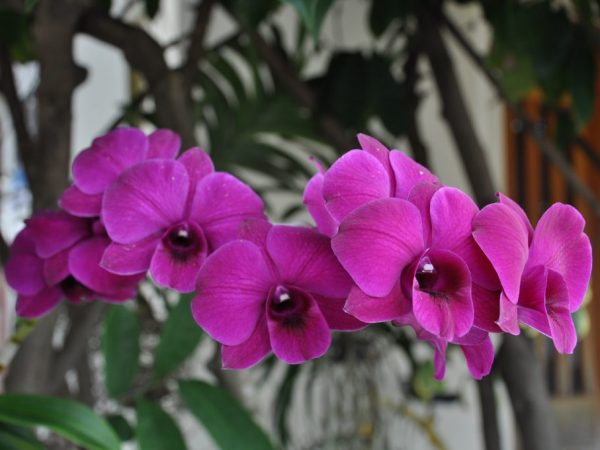
Large and beautiful flowers
The Lelia family came to us from South America. Sizes of flowers - from 1-2 cm to 50-60 cm. Pseudobulbs are oval or elongated, painted gray-green or green, young are smooth, glossy, old ones are wrinkled. Vaginal sheets. Their shape is oval, elongated or belt-like, with a pointed tip. The color of the leaves is green, in the center they are slightly bent along the central vein.
One peduncle develops 1 or 3-10 flowers with a diameter of 15-20 cm. They have 2 petals (petals) and 3 sepals (sepals). The lip is solid and three-lobed, with a smooth or cut fringe edge, completely covers the column. Shades of flowers are varied: white, purple, red, yellow, lilac. The most popular varietal varieties of orchids:
- Double-edged;
- Gould;
- Blushing;
- Gorgeous;
- Purple;
- Tenebros.
The plant is capricious, suitable for experienced growers. Photophilous Lelia requires lighting for at least 10 hours a day. The optimum humidity is 75-85%, the orchid is watered every other day. A mixture of pine bark and sphagnum moss is used as a substrate.
Fragmipedium
The genus Fragmipedium in the wild inhabits the mountainous regions of South and Central America, grows at an altitude of 900-1500 m. It got its name because of the shape of the bud ovary, divided into 3 parts. In the Russian version, this group is called "Lady's slipper".
The phragmipedium does not form a pseudobulb, grows to a height of 1 m, the rhizome is shortened. Leaves are hard, leathery, belt-like, often hanging down. The peduncle is high, up to 1 m, straight or curved in an arc, branches in some varieties. There are few flowers, the petals are narrow, long. The upper sepals are also elongated, sometimes growing up to 40 cm. The lip is wide, insects sit on it. The column is shortened and thick.
The main types of indoor orchids of the genus Fragmipedium:
- Long-leaved;
- Caudate;
- Shlima;
- Besse;
- Kovacs.
Areas where Fragmipedium orchids grow in nature are now intensively cultivated. In addition, the varieties have become popular with collectors, and the bulbs are constantly dug up for sale. As a result, many species are on the verge of extinction.
Odontoglossum
The genus Odontoglossum is widespread in the highlands, it is an epiphyte or lithophyte. Thick pseudobulbs with roots cling tightly to tree bark or stones. The leaves are long, leathery, of a beautiful emerald color. The variety has a tendency to sympodial growth, shoots numerous lateral shoots. The plant itself is small, up to 20 cm in length.
The height of the peduncle is from 10 cm to 90 cm. Up to 10 spectacular and fragrant flowers 4-7 cm in size bloom on one branch. Sepals and petals are narrow. The lip has several leathery outgrowths that resemble teeth, hence the name of the genus. In Greek, odons means tooth and glossa means tongue. The flower is painted in different shades: pink, red, green, yellow, milky, lilac. Brown or burgundy patterns, spots, stripes are visible on the petals.
Main varieties:
- Bikton;
- Large;
- Handsome or Pretty;
- Curly;
- Dew;
- Citric;
- Kripsum;
- Heart-shaped.
Odontoglossum is rarely found in stores, mainly its hybrids are sold. For example, on the basis of Odontoglossum, complex hybrids of Bellar, or Beallar, Kalmanar, or Kolmanar, Burragear, Cichlid were created.
The plant is whimsical, therefore it is not suitable for beginners. Naturally, it grows in cool and humid climates and needs a long period of rest. It is better to grow Odontoglassum in a flowerpot or clay pot.
Tselogin
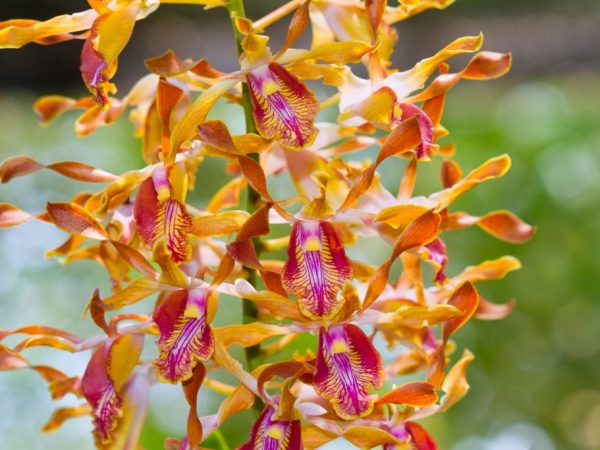
A large number of flowers on a branch
The genus Tselogin comes from southern Asia, is found on the islands of the Pacific Ocean, in India, Vietnam. Plant height - about 30 cm, miniature pseudobulbs, about 3-12 cm in diameter, resemble green grapes. Growing up, Tselogin forms large colonies. Leaves are belt-shaped, with short fleshy petioles. The length of the leaf is up to 30 cm, the width is 3-5 cm; longitudinal relief veins are expressed on the plates.
The peduncle appears in winter, its length is 0.2-0.6 m. The flowers are small, with a pleasant smell, 5-17 pieces per branch. Sepals are lanceolate, sometimes spread out. The lip is three-lobed, with several thick growths. The main colors are white, beige, cream, yellow, lemon.
Common orchids of this species with the names:
- Kristata, or Crested;
- Massange;
- Flacida, or drooping;
- Pandurat;
- Speciosa;
- Fringed.
Celogin is a light-loving plant, therefore it is illuminated 12-14 hours a day. There is no pronounced rest period, the temperature all year round should not fall below 10 ° C. The comb Celdogina is cold-loving, it should not be kept in a room that is too hot.
Habenaria
The genus Habenaria is widespread in Japan, in the East of Asia, in Primorye.Its range covers an area from equatorial forests to temperate zones. Refers to deciduous terrestrial orchids. The plant stretches to a height of 1.5 m. The stem is covered with spiral leaves.
The original flowers bloom on a 30-centimeter branch. Their diameter is 3-6 cm, their size increases as they approach the tropics. Sepals are large, deployed in different directions. The petals are rounded or lanceolate, with a serrated edge. The lip has 1-3 lobes and a fringed edge, the spur protrudes beyond its limits.
The second name of the genus is Lead. There are several varieties of it:
- Eesky;
- Radiant, or radiata;
- Linear-leaved;
- Psychotic;
- Psycho-like large-flowered;
- Ciliated.
In stores, there are mainly tropical varieties of Povodnik, therefore it is better to grow them indoors. The characteristics of the conditions and characteristics of care are the same as for other indoor varieties.
Psychopsis
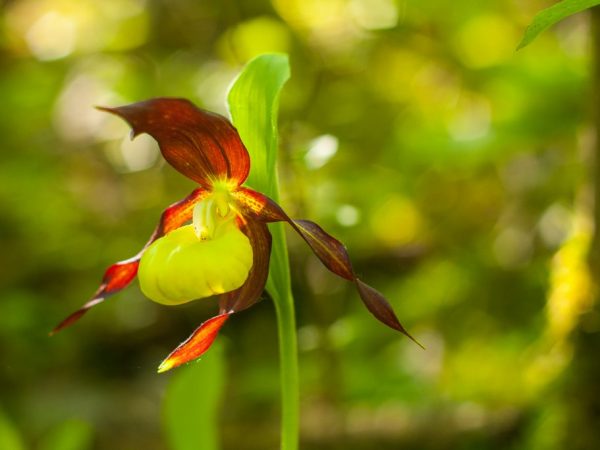
The flower is like a butterfly
The name of the genus Psychopsis is translated from Greek as "like a butterfly." This is due to the special shape of the flowers. Epiphytic plants live in the forests of South America. Rhizomes with false bulbs tightly entwine the bark of trees. The leaves are long, lanceolate. Their color is dark green with a red tint, in some species purple spots are visible. The leaf plate is bent along the central vein.
The peduncle is long, about 1.2 m, 1-2 flowers up to 8 cm in diameter bloom on it. The bud looks like a butterfly pupa, and the flower itself looks like an insect with spread wings. The lateral sepals are rounded, the upper one is elongated and narrow. The lip is fan-shaped, wide. The color of the petals is yellow-orange or yellow, they are decorated with red and terracotta spots.
Popular orchid varieties and species with names:
- Mariposa;
- Papilio;
- Papilio peloric;
- Kalihi;
- Kalihi mountain alba;
- Butterfly or butterfly;
- Mendenhall;
- Cramerian;
- Limminghei;
- Versteegiana;
- Sanderae;
- Alba.
Growing Psychopsis is not difficult, so this flower is recommended for beginners. All varieties need illumination for at least 11 hours a day, the temperature should be maintained at 20 ° C-25 ° C, and the humidity should be 70-80%. The bush is planted in a substrate consisting of the bark of coniferous trees, peat, sphagnum, charcoal, it is also advised to add a nutshell.
Stangopeia
The genus Stangopey is widespread in Latin America. The second name of the genus is the Bull's Head. These are epiphytes with ovoid ribbed false bulbs. The leaves are wide, in the form of a pointed lancet, folded, with distinct longitudinal veins.
The peduncle is directed sideways or downward, which is why varieties are grown in hanging pots or pots, such as gardenias. The flowers are large, up to 20 cm in diameter, 2-7 pieces develop on one branch. The lip has 2 outgrowths resembling bull horns, hence the second name Stangopeia. Orchid colors are different. They exude a strong aroma.
The flowering period is short - only 2-3 days.
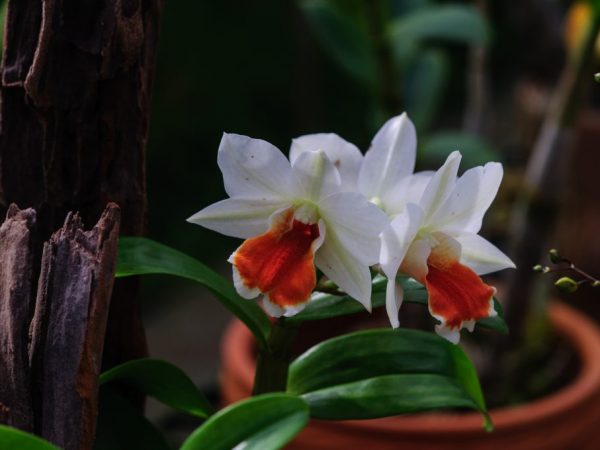
Delicate white orchid
Popular types of orchids of the genus Stangopea:
- Tiger;
- Black and purple;
- Snow-white dawn;
- Ocular.
In summer, a thermophilic plant is kept at a temperature of 20 ° C-27 ° C, in winter - at 10 ° C-15 ° C. During the growing season, watered 1-2 times a week, and during dormancy - 1-2 times a month. The substrate for planting is taken as standard.
The correct cultivation of Srangopea is not difficult, therefore it is recommended for beginners.
Pleione
The Pleione genus has about 20 species. In nature, it is found in China, Vietnam, Thailand. Lives in humid forests or in the mountains (at an altitude of 4000 m) as an epiphytic or lithophytic plant.
False bulbs are small, collected in large groups. The stems are creeping, the leaves are lanceolate, about 15 cm long. The leaves resemble a pleated skirt bent along the central and lateral veins.
The flowers of the wild Pleione orchid are small, in cultivated hybrids they are found in a small form, reaching 10 cm.The lip is tubular or fusiform, fringed, brightly colored in a contrasting color to the rest of the bud. Sepals and petals are set wide apart like a fan.
On the basis of Pleone, about 150 varieties and hybrids have been bred. Here is some of them:
- Hooker;
- Squat;
- Early;
- Graceful;
- Formosan;
- Tongariro;
- Bulbocode.
The plant does not tolerate heat, but low temperatures also harm it. In winter, he begins a period of rest, at which time the pot is removed to a cool room. The species is deciduous, because flowering bushes shed their leaves. It happens in late spring or early autumn.
Oncidium
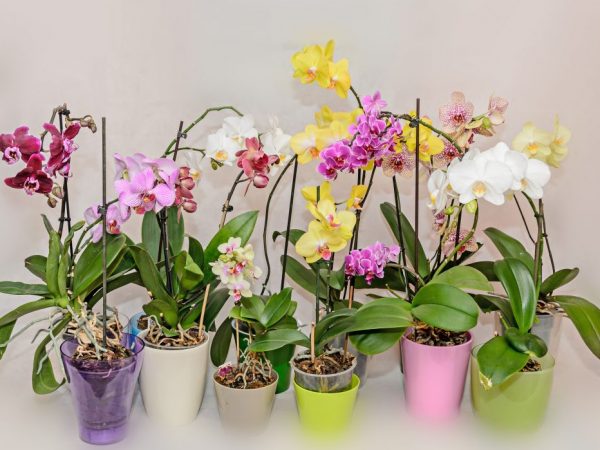
Bright flowers at home
The genus Oncidium is widespread in the South of America, up to Florida, and in the Antilles. It is found in mountainous areas at an altitude of 4,000 kilometers. Grows on trees or stones, stems have a sympodial branching type. The pseudobulbs are large, oval, with lancet-shaped leaves bent along the central vein.
Inflorescences racemose, branched, straight, drooping or arched. Their length ranges from 0.1 to 5 m, and the size of the flowers is from 1-2 cm to 10-12 cm. The sageworts and petals differ little from each other, but in some varieties of sepals they can grow together. The lip is shaped like a guitar, with a scallop at the tip. The color scheme is dominated by yellow and red-brown tones.
Main varieties and hybrids:
- Warty;
- Winding;
- Limming;
- Beautiful;
- Tiger;
- Papilionaceous;
- Lanza;
- Sweet sugar;
- Yellow;
- Twinkle;
- Hoveara.
Indoor orchids Oncidium are among the most popular. When growing, it is recommended to create conditions as close to natural as possible.
Tolumnia
The genus of Tolumnius, or Tolumney, is relatively young. More recently, it was united with the Oncidium clan. The difference between the two is minimal. Distribution area - the islands of the Caribbean. Includes about 30 varieties. Unlike Oncidium, pseudobulbs are absent or practically reduced in Tolumnia. The stem is creeping, the leaves on it are arranged in pairs, sometimes forming rosettes. The plate is fleshy, in the form of a pointed oval or lancet, 5-20 cm in length and 5-15 in width.
The length of the peduncle is up to 75 cm, it contains from 15 to 60 small flowers. Sepals are small, oval or obovate, narrow. The petals are larger, with wavy or jagged edges. The lip is of a complex structure, opens in a wide fan, three-bladed and divided. It is 2-3 times larger in size than the rest of the flower. The color of the petals is different.
Popular varieties of real Tolumnia:
- Variegata;
- Guiana;
- Beautiful;
- Tsiku Vanessa;
- Catherine Wilson;
- Charming.
Suitable for experienced orchid lovers. It grows well at room temperature, but at night the indicator is lowered by 3 ° -5 ° C. Daylight hours should last 1-10 hours. The optimum humidity is 45-70%. Instead of watering, it is advised to immerse the entire pot in warm water. Tolumnia is fed every 5 waterings, after she has released flower stalks.
Ascocentrum
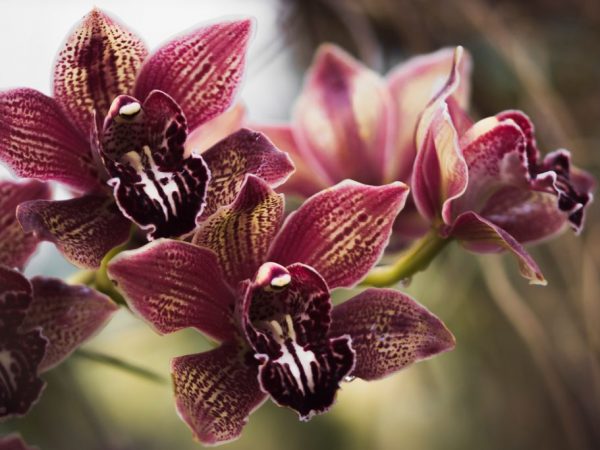
The color is very bright and noticeable
The genus Ascocentrum has about 9 varieties. Distributed from the Himalayas to the Philippines. On the basis of the genus Ascocentrum, many varieties and hybrids have been bred. This is a dwarf epiphytic orchid that has creeping shoots. The leaves are narrowed, dark green, their length is about 10 cm.
The inflorescence is racemose, straight or slightly drooping, there are more than 10 small flowers on it. The petals are wide open, the lip is three-lobed, sometimes fused with the column by the lateral lobes. The spur is short, at the throat it has a swelling resembling a bag. Hence the name of the genus comes, "ascos" in Latin means "bag". The color of the flowers is bright and varied.
Main varieties and hybrids:
- Matte red;
- Curved;
- Miniatum;
- Ampulaceum;
- Aurantiacum;
- Сhristensonianum.
Care for these orchids is standard. They love heat and humidity. Reproduction is carried out by cuttings.Transplanted into a new pot every 2-3 years.
Brassia
The genus Brassia is sometimes affectionately called "spider". It has 30 species and is common in the tropical rainforests of America. It has single pseudobulbs, which are sometimes collected in small heaps. Leaves are lanceolate or belt-shaped, fan-shaped around the stem. The variety is epiphytic, with numerous aerial roots.
The genus got the name "spider" because of the original flowers. They have thin, retracted petals of a yellow or brown hue. On the surface there are pimples in a color contrasting with the main tone. Sepals reach 15 cm in length, while remaining narrow, similar to the legs of a spider. Inflorescences racemose, each developing up to 15-20 flowers.
The main types of spider orchids:
- Warty;
- Tailed;
- Royal;
- Spotted.
Brassia is a relatively new genus, which at the same time is considered one of the most original. These are unpretentious home orchids, even beginners can grow them. If you provide growth conditions close to natural, the culture will delight the owners with flowering almost all year.
Felenopsis
Felenopsis orchids are among the most popular indoor plants. Epiphytic herbaceous plants came to us from Southeast Asia and the Philippines. Their stems are shortened and grow only upward, release aerial roots. Leaves are leathery, do not fall off, 4-6 pieces grow on one branch. The color of the plate is dark green; many species have a marble pattern.
Peduncles are long, often branch, produce several large flowers, shaped like a butterfly. The colors are different, there are flowers in white, pink, red, yellow, purple, blue and even black. These are real rainbow butterflies, and each hybrid smells differently.

Flowers are in demand
Today Felinopsis ranks first in sales. Here's a kaleidoscope of popular varieties:
- Sacramento;
- Sorrento;
- Lottery;
- Stone rose;
- Deerhorn;
- Horse;
- Stewart;
- Schiller;
- Pink;
- Charming;
- Purple;
- Ludemann;
- Manna;
- Sumatran;
- Sander;
- Dendrobium;
- Sakura;
- Blue Orchid, or Turquoise;
- Royal, or "Elephant Ears";
- Black Pearl;
- Dutch;
- Sahel.
Felinopsis care is simple. The plant requires good lighting, warmth in summer and coolness in winter. It will not be difficult to buy it either, even elite varieties are sold in almost all flower shops.
Temperate orchids
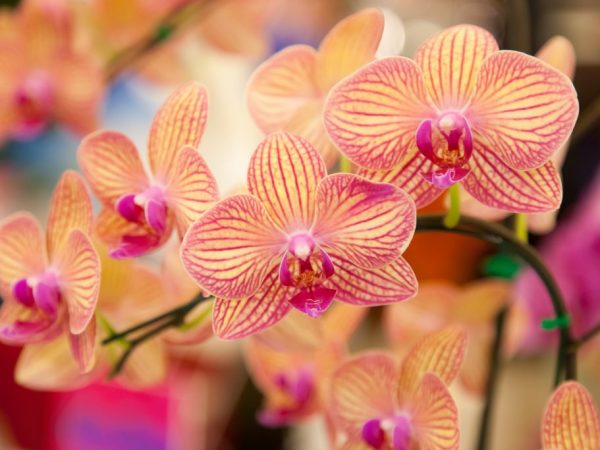
Orchids grow in nature
In the temperate climatic zone, in the north of America and Eurasia, there are also representatives of the Orchid family. Often these are inconspicuous flowers with spike-shaped inflorescences that hide in the shade of coniferous and deciduous forests, some grow in the highlands. Most varieties are terrestrial, deciduous, like tropical relatives, they love moisture, but are resistant to cold.
Ophris
The genus Ophris includes terrestrial orchids. The stems have a cylindrical shape, small leaves are collected in the lower part into a socket. Inflorescences are racemose. The bracts fall off, the sepals in some representatives hang over the column, have a green, pink or white tint. The petals are small, threadlike, the lip is long, with an interesting pattern, in some varieties - with an edge.
The main types of Ophris:
- Bee-bearing;
- Bumblebee;
- Lead-bearing;
- Dark;
- Insect-bearing;
- Kopetdag;
- Yellow;
- Woodcock;
- Mirror;
- Caucasian (almost extinct species);
- Siberian.
Growing orchids of this variety and species at home is not very popular. But it is often planted in flower beds, in gardens, used to decorate alpine slides. In nature, it is found in the Caucasus, in the region of the Usman River, in the Volga region, on the coast of the Caspian Sea.
Goodayera
The Goodayer genus is a terrestrial deciduous plant that is found in coniferous shady forests. The root system is located in a litter of leaves and needles.The leaves are lanceolate, sometimes with white spots, the stem is fragile, 20-25 cm in height.
Flowering begins in May-June. On the arrow, 10-30 white or creamy fragrant flowers are formed, collected in a spike-shaped inflorescence. They constantly turn to the sun throughout the day. In appearance, Goodayera looks like a lily of the valley, it is often confused with this plant.
Popular varieties:
- Menzis;
- Creeping;
- Fluffy;
- Maksimovich;
- Schlechtendahl.
Goodayera is planted in a moderately shady and humid area. Direct sunlight will burn her, with a great lack of light, she will switch to an underground lifestyle. The soil is chosen neutral or sour.
Ladian
The Ladian clan has about 15 representatives. A feature of the plant is the complete absence of leaves and chlorophyll. It feeds on a saprophytic fungus enveloping a wide coral-shaped rhizome.
The stem is short, yellow in color. It develops from 2 to 40 flowers, collected in a spike-shaped inflorescence. Bracts are small, light green. Petals are oblong, lanceolate, their size is 4-6 mm. The lip is no more than petals, three-lobed, with small teeth. The flowering period is May-June.
The most famous orchid variety is Three-cut. It is found in the European part of Russia, in the Caucasus and is endangered. It is a small plant with white-yellow or brown flowers that appear in late June or early July. Prefers moist coniferous or deciduous forests.
Kokushnik
The genus Kokushnik has only 15 species, in Russia there are 4. It is a terrestrial plant with a thin stem. The leaves are lanceolate or linear, arranged alternately, with the base covering the stem.
The inflorescence is spicate, it contains dozens of small flowers. The column is short; sepals and two petals form a kind of veil over it. The lip is diamond-shaped, three-lobed, with a filamentous spur at the end. The color of the flowers is white, purple, pink or purple.
Common types of Kokushnik:
- Fragrant;
- Densely flowered;
- Komarnikovy;
- Kamchatsky;
- Long-horned.
This genus of orchids is rarely bred at home, it is more common in the wild.
Pollen head
The genus Pollenhead, or Cephalantera, encompasses 14 species. According to the description, it is a terrestrial herb with a straight or winding stem, some varieties lack chlorophyll. The leaves are located at the rhizome or alternately on the stem, lanceolate, small, underdeveloped in mycoheterophytes.
The flowers are collected in a loose spikelet-type inflorescence. Their diameter is relatively large - 1.5-2.5 cm. The sepalifiers are free, almost the same size. The petals are short, the lip is two-lobed. The column and anther are straight, the ovary is curved into an arc. The flowering period lasts from May to June.
On the territory of Russia there are the following types:
- Long-flowered;
- Red;
- Large-flowered;
- Caucasian;
- Kurdish;
- Lush blooming.
The pollen head grows in shady, humid places, most often found in deciduous forests. It is easy to determine the type of this orchid by the characteristic arched peduncle and the lip of the flowers divided in two. Recently, it has been found in flower beds and gardens.
Summarizing
Not all varieties worth knowing about are listed in the material. Only an impressive reference guide can accommodate them. There are interesting varieties that are rare in our country. For example, the Australian duck orchid Big Kalania or the Flying Duck resembling platypus-shaped water birds, the mysterious leopard orchid from the Philippines, or the Darwin Star from Madagascar.


